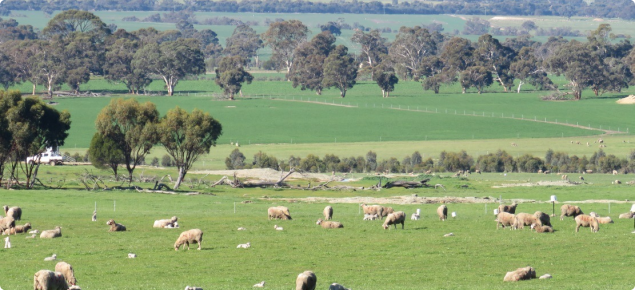Introduction
Research conducted in the 1990’s found that intensively grazing pastures for the whole of spring controls RLEM as effectively as insecticides. Yet the tactic has not been adopted by producers due to the impractical number of sheep required for months for one paddock. It is however reasonable to expect that some if not all of the benefits could be realised by much shorter periods of intensive grazing.
Insecticide resistance has recently arisen in RLEM populations in parts of the grain belt renewing interest in alternative control methods such as intensive spring grazing around the Timerite® period. Grazing is an attractive option as it possibly has multiple benefits such as improved yields in following grain crops and better weed control in spring pasture.
While any producer with a mixed farming enterprise could benefit from a spring grazing package aimed at controlling RLEM we expect the largest benefits to be for those in the medium to high rainfall zones with more pasture feed-on-offer (FOO) and bigger RLEM populations. The cost to implement this spring grazing package in most cases would be zero however it would require some additional labour.
Given that in the absence of chemical control options resistant RLEM’s could reduce crop yields by up to 30% at a loss of around $74/ha. A spring grazing package could recover a substantial proportion of these losses.
Method
In 2019 and 2020, three on-farm demonstrations at Boyup Brook, Cranbrook and Kalgan compared intensive grazing for 2 and 4 weeks in spring, around the Timerite® date, to an ungrazed control. In each year, trial sites were established on new sites. Intensive grazing involved maintaining pasture FOO at approximately 1.4 tonne dry matter per hectare (t DM/ha). Pastures were assessed weekly in 2019 and fortnightly in 2020; in each year RLEM were sampled fortnightly in spring and following the break of the growing season in the following year.
RLEM were suction sampled using a Stihl™ blowervac BG55. The nozzle of the blowervac had a sieve with fine mesh (holes at ~10 µm) placed 5cm into the aperture of the blowervac. The nozzle of the blowervac was held on the ground for two seconds and 10 suction samples were taken per sample jar containing 10mL of 70% ethanol. A total of 10 sample jars were collected per treatment. In spring 2019, collections were taken at fortnightly intervals starting from around the Timerite® date, while in 2020 collections were taken following the break of the growing season and again one month later. Mites were counted under a dissecting microscope.
Pasture FOO was determined using the calibrated visual assessment technique of Campbell and Arnold (1973). At each sampling 60 individual visual assessments were made for each treatment using a quadrat (0.1m2) these estimates were related to actual FOO by taking 7 to 10 calibration cuts.
Numbers of RLEM and FOO in each treatment was then compared using an analysis of variance (ANOVA), with each site used as a replicate.
In the January and February of 2021 we took 90 soil samples to a depth of 10cm for each of the treatments at all three sites and analysed them for nitrate and ammonium nitrogen.
Results and discussion
2019
In Cranbrook, at the commencement of the demonstration, pasture FOO was low for a spring pasture at 2.5t DM/ha. Grazing for either 2 or 4 weeks only reduced FOO to around 2t DM/ha. At the end of this four week period FOO in the ungrazed treatment had only increased by around 0.7t DM/ha FOO indicating relatively low pasture growth rates. Also grazing did not cause a significant reduction in RLEM numbers and by mid-October, RLEM numbers in all treatments had crashed. For this reason, Cranbrook was not included in the analysis of data.
In comparison at Kalgan and Boyup Brook, FOO in ungrazed pasture on average increased by 2t DM/ha over spring. After two weeks of grazing, FOO was maintained at approximately 2t DM/ha but after livestock were removed (13 Oct) from the two week grazing treatment, FOO increased by 40%. In comparison, four weeks of grazing led to a 60% reduction in FOO as compared to the ungrazed treatments. In this treatment average FOO averaged 2t DM/ha (Figure 1).
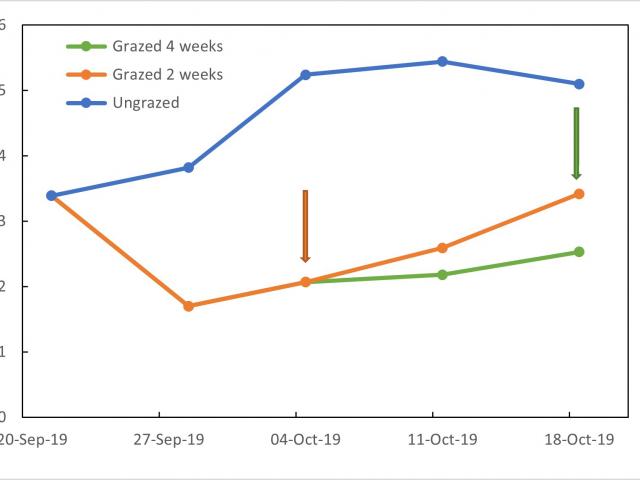
Grazing led to a reduction in RLEM numbers. Compared to the ungrazed control, two weeks of grazing resulted in a 90% reduction in RLEM numbers, but once livestock were removed, RLEM numbers tripled. However, grazing for four weeks decreased RLEM to less than 100 per square metre (P=0.01) (Figure 2).
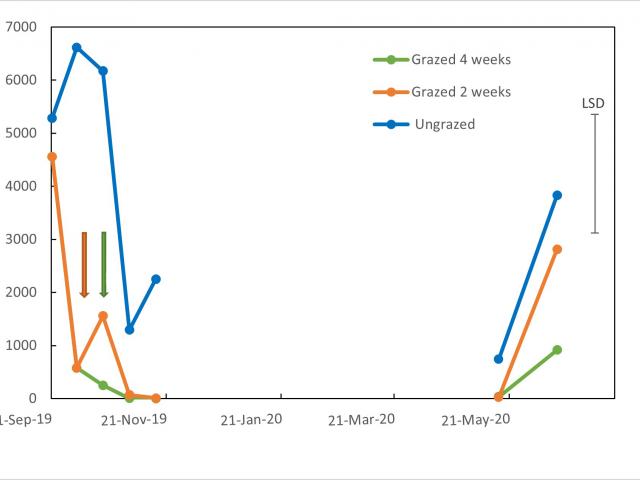
Sampling in early autumn of the following year, RLEM were only found in the ungrazed treatment. By mid-autumn, the four week grazed treatment had less than 500 RLEM per square metre (P= 0.01). This is ten times less than the threshold for mites in cereals (equivalent to 5000 mites per square metre) and five times less than the threshold for canola (equivalent to 1000 mites per square metre) (Figure 2).
2020
All three sites had similar FOO at the start of the season of approximately 3t DM/ha. Thus all three sites were used in analysis.
Like 2019, grazing for two weeks led to average FOO of 2.5t DM/ha, whereas grazing for four weeks, led to an average FOO of 2t DM/ha. By the end of spring ungrazed treatments had on average 40% more FOO than grazed treatments (Figure 3).
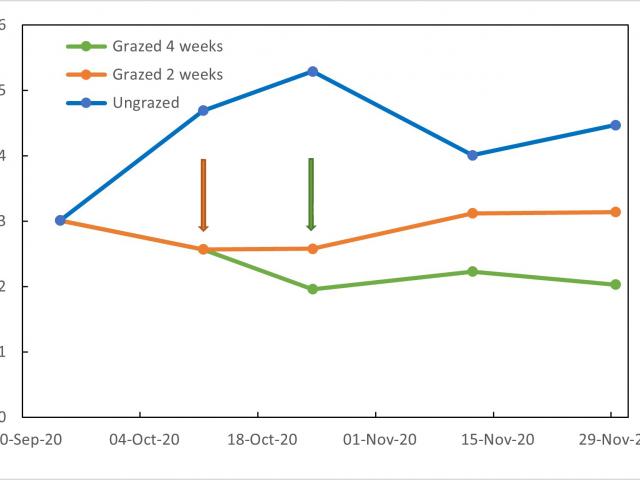
Grazing also led to a reduction in RLEM numbers. After two and four weeks of grazing, there was on average a 90% reduction in RLEM when compared to the control. However, in the following year, a significant reduction (P=0.1) in RLEM numbers was only seen in the 4 week grazing treatment. Numbers of RLEM were about 5000 per square metre, indicating these mites were below threshold for growing a cereal crop (Figure 4).
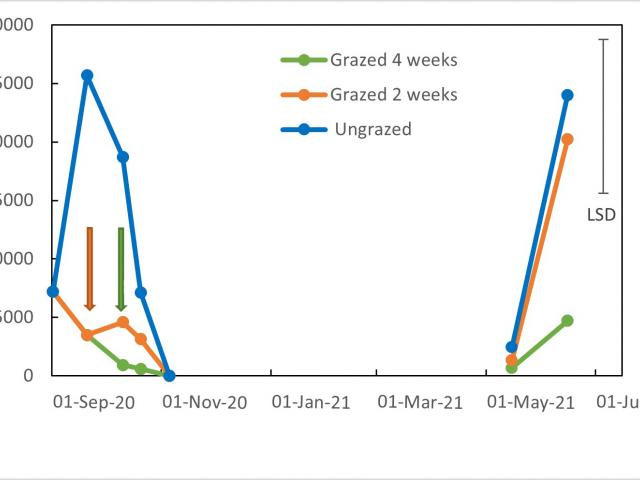
Soil mineral nitrogen
At the Boyup Brook and Cranbrook site four weeks of intensive grazing in spring resulted in higher soil mineral nitrogen (N) than the ungrazed control. On average across both sites this equated to an additional 38 kg N/ha being carried over to the following pasture or crop. Two weeks of intensive grazing typically resulted in much smaller amounts of additional soil N with an average of 3kg N/ha becoming available in the following season. Unlike the Boyup Brook and Cranbrook sites with annual pastures the Kalgan site was established on a pasture that included a summer-active grass (kikuyu) because this grass took up soil N in January and February 2021 the soil mineral N data in relation to the grazing treatments is inconclusive.
While the impact of intensive spring grazing on soil mineral N was only examined once and, the findings suggest that four weeks of intensive grazing in spring will increase the amount of soil mineral N available to crops or pastures in following seasons.
Conclusion
Intensive grazing in spring appears promising as a tactic for suppressing RLEM for the following season. However, it should only be used when the population of mites is above 5000 per square metre and FOO is more than 3t DM/ha. To reduce RLEM’s the pasture needs to be grazed to a FOO of 2 t DM/ha or less for four weeks around the Timerite period to achieve a significant reduction in mites the following season. The aim is to have less than 1000 mites per square metre in the following season which is below the damage threshold for canola. Control measures for canola, such as seed dressings, may still be required to protect the crop from RLEM damage.
Acknowledgments
This research has been made possible by funding from the Small Farms, Small grants, Department of Agriculture and Water Resources. The authors wish to thank Fitzgerald Biosphere Group, Southern Dirt, Gillami and the farmers on whose properties these demonstrations were conducted.
References
Campbell NA, Arnold GW 1973 The visual assessment of pasture yield. Australian Journal of Experimental Agriculture and Animal Husbandry 13, 263-267.

